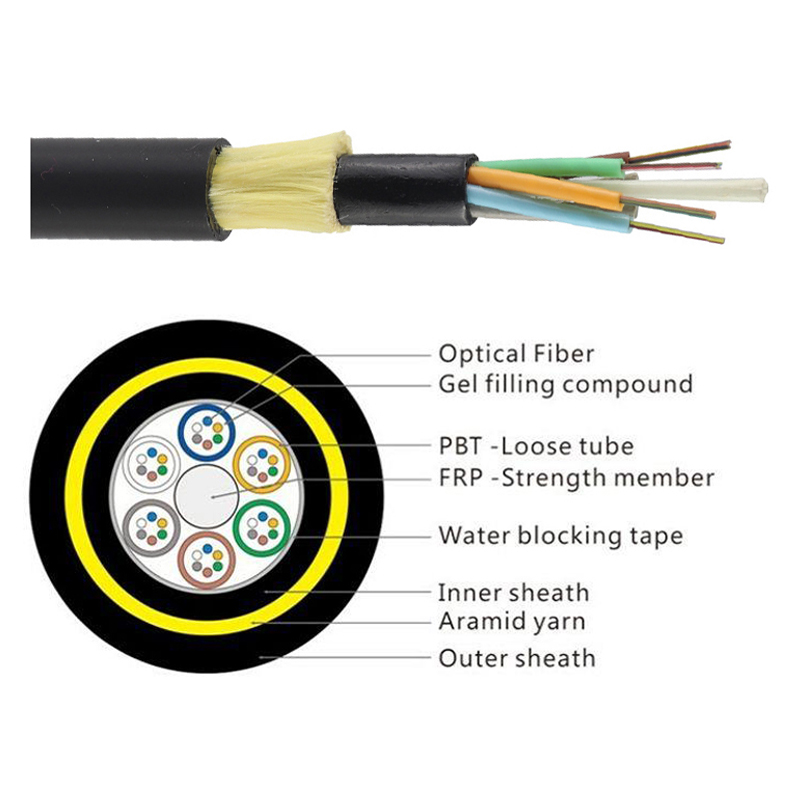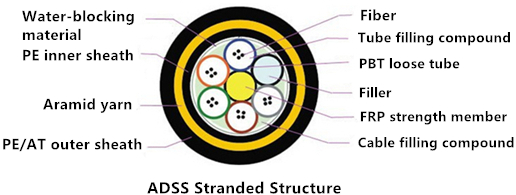In the realm of modern telecommunication and power transmission, fiber optic cables have revolutionized data transfer and communication processes. Two widely-used types of fiber optic cables are Optical Ground Wire (OPGW) and All-Dielectric Self-Supporting (ADSS) cables. While they both serve similar purposes, there are significant differences in their construction, applications, and advantages. This passage aims to elucidate these distinctions and highlight the unique features of each cable type.
What is OPGW Cable?
OPGW Cable: Optical Ground Wire (OPGW) is a dual functioning cable, meaning it serves two purposes. It is designed to replace traditional static / shield / earth wires. Optical Ground Wire (OPGW) is a hybrid cable designed for power transmission lines, where it acts as both an electrical ground wire and a fiber optic cable. The central core of OPGW is composed of several steel wires or aluminum-clad steel wires for mechanical strength and electrical conductivity. Surrounding the central core are optical fibers, protected by layers of stainless steel tubes or aluminum-clad steel tubes. These layers provide mechanical protection to the fibers and ensure that the cable can withstand the mechanical stresses associated with the power lines.
You can find us in b2blistings.org’s <a href=”https://www.b2blistings.org/Building-and-Construction/Trades/C3-76-1-0.htm”>Trades Directory</a>
What is ADSS Cable?
ADSS Cable: All-Dielectric Self-Supporting (ADSS) cable, as the name suggests, is an all-dielectric cable that does not contain any metal components. As a kind of self-supporting cable. ADSS (All-dielectric Self-supporting) cable is designed for aerial installation and deployment, which is suitable for various outdoor applications.The structure consists of a central core made of optical fibers, surrounded by layers of aramid yarns or glass-reinforced plastic rods for strength. The dielectric nature of the ADSS cable allows it to be self-supporting, meaning it can be installed on poles or towers without requiring a separate messenger wire for support.
1. About Applications:
OPGW Cable: OPGW cables find extensive use in power utility applications, specifically in high-voltage transmission lines. They serve a dual purpose: providing a reliable grounding path for lightning currents and offering high-capacity communication capabilities for various services, such as telephony, data transmission, and internet connectivity. OPGW cables are often preferred in power transmission lines due to their ability to withstand high electrical and mechanical stresses.
ADSS Cable: ADSS cables are predominantly employed in telecommunication networks, including both long-distance and short-distance installations. They are ideal for applications where metallic cables might interfere with existing power lines or in areas prone to lightning strikes. ADSS cables are commonly found in distribution lines, access networks, and in areas with high electromagnetic interference (EMI) concerns. ADSS fiber optic cable is small in size, light in weight, strong in structure, and flexible in applications, which is suitable for most outside aerial deployments. The small and light nature of the ADSS cable will reduce the load on tower structures for some external influencing factors like cable weight, wind, ice, etc. The structure design will not only prevent moisture and chemical attacks but also will protect the polymer strength elements from the effect of solar ultraviolet light. Besides, the strong structure will also allow up to 700m lengths to be installed between support towers.
2. About Advantages:
OPGW Cable:
- Enhanced Lightning Protection: OPGW cables’ metal components provide an excellent path for diverting lightning currents away from the power lines, ensuring the safety and integrity of the electrical network.
- High Data Capacity: With multiple optical fibers, OPGW cables offer high data-carrying capacity, making them ideal for fulfilling the communication needs of power utilities.
ADSS Cable:
- Lightweight and Easy Installation: The absence of metal components in ADSS cables makes them lightweight, simplifying installation and reducing the load on support structures.
- No Grounding Requirement: ADSS cables eliminate the need for a separate grounding conductor, making installation more straightforward and cost-effective.
- Immunity to Electrical Interference: Being all-dielectric, ADSS cables are not susceptible to electromagnetic interference, ensuring reliable data transmission in challenging environments.
3. About Cost Considerations :
OPGW Cable: OPGW cables are generally more expensive than ADSS cables due to the additional cost of the metallic components and the complexity of their design. However, considering their dual functionality of providing communication and grounding capabilities, they often prove cost-effective for power transmission applications.
ADSS Cable: ADSS cables tend to be more cost-efficient due to their all-dielectric design, lower material costs, and simpler installation process. In telecommunication installations, ADSS cables offer an attractive balance between performance and cost.
4. Conclusion:
OPGW and ADSS fiber optic cables serve distinct purposes and are tailored to suit specific applications. OPGW cables find prominence in power transmission lines, providing both grounding and communication capabilities. On the other hand, ADSS cables are primarily used in telecommunication networks due to their all-dielectric construction and immunity to electrical interference. By understanding the differences between OPGW and ADSS cables, telecommunication and power transmission industries can make informed decisions regarding their implementation, optimizing their networks for efficiency and reliability.
The choice between OPGW (Optical Ground Wire) and ADSS (All-Dielectric Self-Supporting) fiber optic cables depends on various factors, including your specific application, budget, environmental conditions, and other project requirements.
If you are primarily focused on communication and require lightweight and easy installation, ADSS may be the better choice. On the other hand, if you need a combined solution for power line protection and communication, and you are dealing with high-voltage power transmission, OPGW might be the more appropriate option.
As with any infrastructure decision, it is crucial to consult with experts in the field - Hunan Jiahome and conduct a thorough analysis of your project’s specific requirements before making a final decision. Before contacting Jiahome you can browse more cables and choose the one you may need first: https://www.jiahomeopticable.com/products/
About Hunan Jiahome:
Hunan Jiahome Technology Co., Ltd. is a high-tech fiber optic cable factory in China that can produce the most complete series of fiber optic cables, equipped with the most advanced fiber optic cable manufacturing, and have the most advanced fiber optic connector production and testing equipment in China.
The factory has a registered capital of 50 million yuan, total assets of 360 million yuan, and more than 500 employees. Has obtained SGS ISO9001-2015, ISO14001-2004 and GB/T28001-2001 successively obtained international system certification; EU CPR certification; Brazil Anatel certification.
Over the past 15 years, we have provided optical cable products and comprehensive solutions to more than 90 countries and regions around the world, and have received unanimous praise from customers.
Post time: Aug-03-2023



